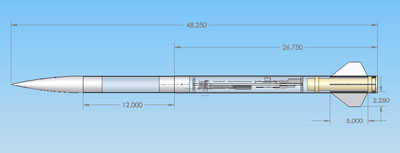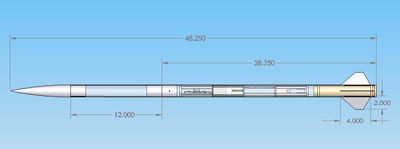The Laboratory Experiments

The Structure of the Laboratories
The laboratory sessions are divided into four parts. Part 1 (Lab 1) introduces rocket flight and data acquisition and processing as an overview for the course. Part 2 (Lab 2) teaches the basics of electrical and computer measurement of sensors, and lab report technique. Part 3 is the rotating labs and teaches how potential sensors for the rocket work and what is necessary to model an actual flight. Part 4 is the design, manufacture, testing, and redesign of your sensor package, actual field launches, analyzing the data, and presenting the results. It's your chance to apply everything you've learned and show off to other people what you've learned.
Information about the Laboratories
- First Flight – Build and fly a model rocket with an on-board altimeter. Analyze the flight data and compare them with inclinometer data and a computer flight simulation.
- Voltage Dividers – The fundamentals of voltage dividers, input and output impedance, complex impedance, and using basic electrical equipment such as voltmeters, oscilloscopes, and signal generators. You will also learn how touse a thermistor. This information is foundational to most of the measurements you will make in E80.
- Op-Amps & Sig. Cond. – The use of op-amps to condition signals to and from transducers and sensors. Signal conditioning is necessary interfacing with data acquisition systems (DAQs) and data loggers.
- Temperature – Temperature measurement is one of the fundamental measurements in almost all physical systems.This lab exploresthermocouples, thermistors, and cold junction compensation.
- Wind Tunnel – Learn to deal with dimensionless parameters. Measure the drag force on the rocket both parallel and normal to the axis of the rocket. Calibrate the Pitot tube in the rocket nose cone.
- Static Test & Flight Model – Perform static motor tests to measure the thrust curves of the motors. Calculate performance indexes for the motors. Model the flight of a rocket using the thrust curve and compare with commercial software.
- Accel & Gyro Cal – Use a turntable to calibrate accelerometers and rate gyroscopes and learn to interpret data from them.
- Final Project – Determine what scientific/engineering goals you have for your rocket flight. Design and build your flight data system and your rocket. Go out, launch rockets, collect and analyze your data. Fix the problems and try again. Remember, the emphasis is on collecting, analyzing, and presenting the data, not the visceral rush. Enjoy the rush during the other teams' flights.
- Flight Report – Finish your data analysis, write a final report, and prepare a presentation.
The Course Lectures

The Purpose of the Lectures
There is a series of approximately 14 lectures that will be given on Tuesday and Thursday mornings at 9:35 AM in Galileo Edwards. The purpose of the lectures is to give you background information, references, and hints for each of the experiments. The lectures don't correspond exactly to the laboratories and information from a given lecture may be useful in one or more laboratories. Professor-generated notes relating to a given lectures will be available on-line after the lecture and if possible before the lecture. There may be hand-outs given out during the lecture which may never make it to an on-line version.
Information about the Lectures
- Introduction & First Flight – Why are we doing this? What are we doing? How are we going to do it? What happens in the first lab?
- Data Fitting and Analysis – How good are your measurements? How sure are you? How do you optimally regress your data? How good is your calculated result? What about quantization errors?
- LabVIEW & MATLAB – LabVIEW is the de facto standard for performing computer controlled experiments. Matlab is the de facto standard for systems modeling and data analysis. This lecture covers the basics of LabVIEW and how you would interface it with Matlab. It's an introduction to your textbook.
- Basic Electrical Measurements – The fundamentals of voltage dividers, complex impedance, and using basic electrical equipment such as voltmeters, oscilloscopes, and signal generators. This information is foundational to most of the measurements you will make in E80.
- Operational Amplifiers – Basic op-amp circuits such as the buffer amp, and inverting summer. The are the building blocks for conditioning analog circuits and preparing them for input into data acquisition systems (DAQs).
- Temperature Measurement – Temperature is the most common physical measurement. Find out how thermocouples, thermistors, and instrumentations amps are used to measure temperature.
- Fluid Measurements – A knowledge of the drag force on a rocket is critical to modeling its atmospheric flight. The rocket also has a Pitot sensor. This lecture describes the methods for measuring drag force and correlating the results. It also describes dimensionless parameters, and how a Pitot tube works.
- Thrust & Flight Modeling – An essential component of modeling a rocket flight is a knowledge of the thrust curve of the motor. This lecture discusses measurement of thrust curves, and use of thrust curves and drag data to predict or model the flight of a rocket.
- Inertial Measurement – Many commercial rockets have an on-board set of inertial measurement sensors. This lecture discusses how the sensors work and how to analyze the data from them to measure the position, velocity, and orientation of a rocket during flight.
- Vibration & System ID – Many of the past students have chosen to measure modal vibrations on a rocket. This lecture is an explanation or review of how to model vibration in simple structures, measure vibration, and identify a system from its frequency response.
- Sensors & Transducers – There are a lot of sensors out there gthat we don't have time to cover for the whole class. What are some of the ones you may want to fly? How do they work, and how can you interface them with a data logger?
- Atmospheric Science – How and why you measure properties of the atmosphere with sounding rockets, balloons, aircraft and ground- and space-based sensors. This lecture would be useful if you wanted to do science with the rocket instead of just measurements about the rocket.
- Flight Hardware – NASA and the military have a whole set of procetdures they go through to get an experiment ready to fly. This lecture will go over many of the design and construction principlesthat will be useful to you as you design, build, test and fly your experimental package.
- Field Operations & Safety – We want everyone to have a safe and successful flight. This lecture will cover the safety principles, safety rules, and other guidelines for conducting field work and flying rockets.
Additional References
Additional information that may prove valuable for the course is given in the links below:
The myDAQ manual.
The oscilloscope (Agilent 2024A, and spec sheet) manual.
The function generator (HP/Agilent 33120A) manual..
The Elenco LCM-1950 DMM users manual.
The HP 6236 power supply users manual.
A review of the sampling theorem.



